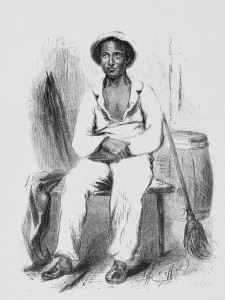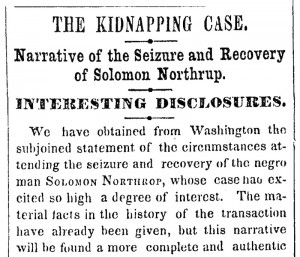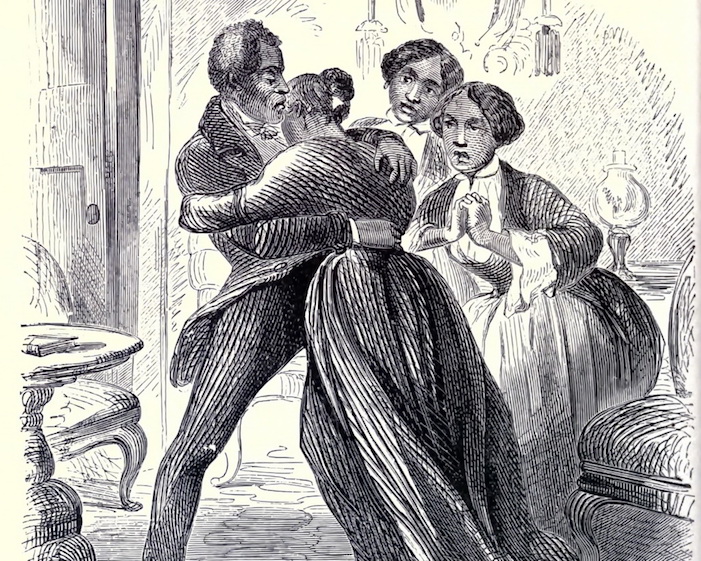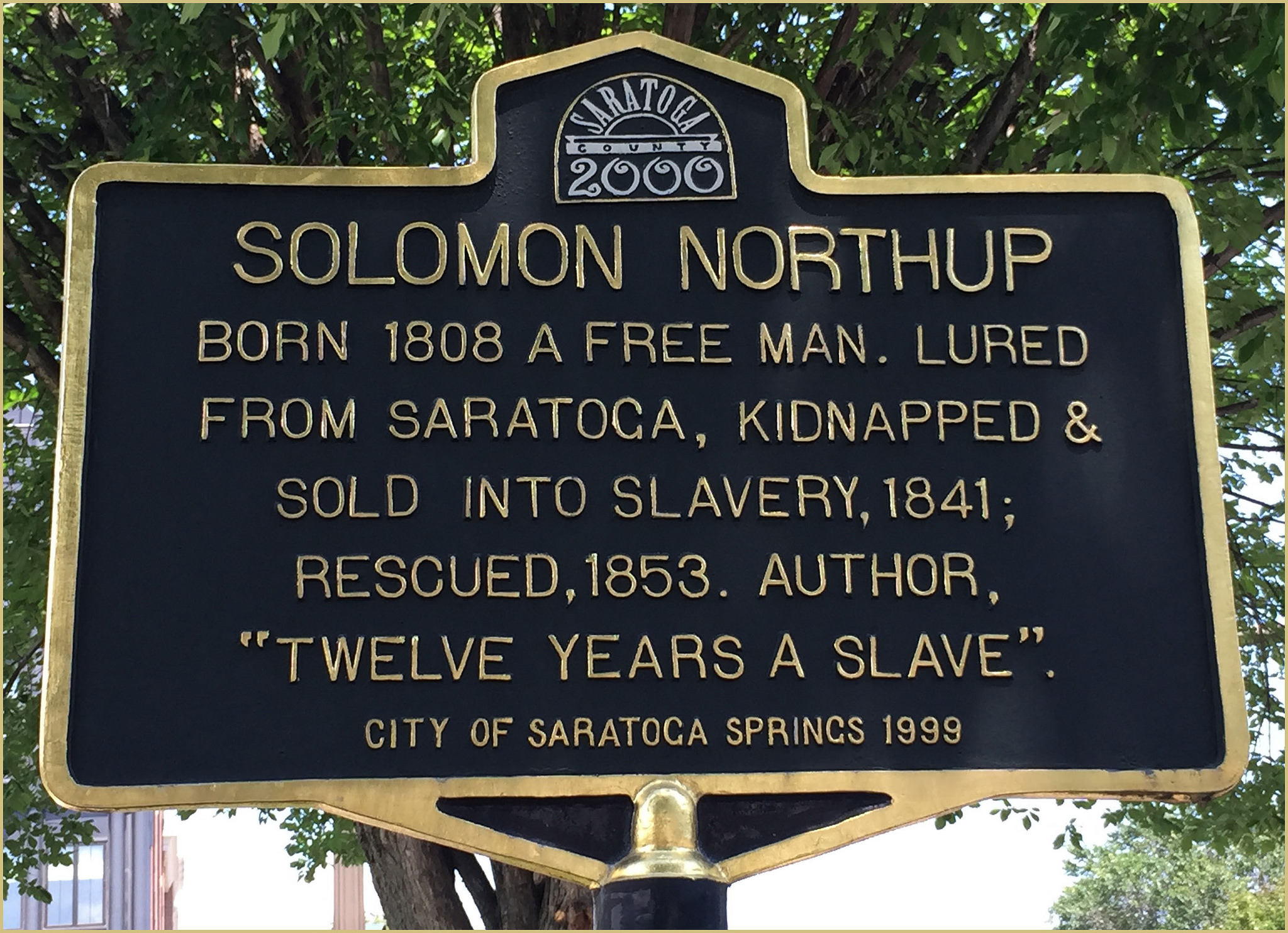
Solomon Northup was a free black man from Minerva, New York who married the love of his life on Christmas Day in 1829.
Northup was born in July of 1808 to a freed slave, Mintus, and a “woman of color” (reportedly one-quarter African-American, and three-quarters European) whose name is unknown. He was raised on the farm that his father owned with his brother Joseph, where he occupied himself with books and music (the violin, specifically) when he wasn’t working. In his memoir, he refers to the violin as “the ruling passion” of his youth. Northup enjoyed a comfortable upbringing and what was considered a high education for free black folks at the time.
In 1834, Northup and his wife, Anne Hampton, moved to Saratoga Springs, New York in search of employment opportunities after selling their farm. During the tourist season, the couple worked for the United States Hotel—where his wife worked as a cook and he played the violin—which was among the nicest in the nation at the time. The couple gave birth to three children, Elizabeth, Margaret, and Alonzo, and did well for themselves. Seasonal work was a challenge at times, however, and Northup worked odd jobs to supplement his income while building his reputation as a professional musician.
While seeking employment one day, Northup met two friendly strangers, who identified themselves as Merrill Brown and Abram Hamilton, at a local tavern. The gentlemen told Northup that they worked for a circus company, then located in Washington D.C., and traveled from city to city presenting the show. As fate would have it, they told him, they were looking for a man with just his talents.

The men implored Northup to urgently travel with them to New York City, performing at a few shows along the way. Once in New York, they offered Northup higher wages if he accepted a traveling musician contract in Washington, D.C. Tragically, the men had sinister plans. Not only had they provided fake names (their real names were Alexander Merrill and Joseph Russell), they plotted against him. There are differing accounts of what happened next, but what we know for sure is that Northup was drugged, kidnapped, and sold into slavery for $650.
During this time, his family had no way of knowing where he was. Once the initial New York City trip was set into motion, Northup returned home from the tavern just long enough to grab his violin. His wife was working Sandy Hill (about 20 miles away) at the time and he neglected to leave a note, expecting to return before long with ample compensation to justify his hurried departure. When he was abducted, his children were 10 (Elizabeth), 8 (Margaret) and 5 (Alonzo).
***
Following his kidnapping and realizing his predicament, Northup explained to slave dealer James H. Birch that he was a free man, and requested that his shackles be removed. For the audacity of this request, Northup was beaten severely. “Even now the flesh crawls upon my bones, as I recall the scene. I was all on fire. My sufferings I can compare to nothing else than the burning agonies of hell!” Birch promised to kill Northup if he told anyone else that he was a free man.
Northup was shipped to the Red River region of New Orleans with other slaves, eventually being sold to Edwin Epps for whom he worked for nearly a decade. Epps was a notoriously cruel master, known for his violence towards and sexual abuse of his slaves. The sound of slaves being whipped was reportedly heard from sun up to sun down on his Louisiana plantation.
Northup devised several plans to escape slavery, most of which obviously failed, but he dared not reveal to the other slaves that he was once free for fear of being sold to a more remote location.
“Oh! How heavily the weight of slavery pressed upon me then. I must toil day after day, endure abuse and taunts and scoffs, sleep on the hard ground, live on the coarsest fare, and not only this, but live the slave of a blood-seeking wretch, of whom I must stand henceforth in continued fear and dread.
Why had I not died in my young years-before God had given me children to love and live for? What unhappiness and suffering and sorrow it would have prevented. I sighed for liberty; but the bondsman’s chain was round me, and could not be shaken off. I could only gaze wistfully towards the North, and think of the thousands of miles that stretched between me and the soil of freedom, over which a black freeman may not pass.”
—Solomon Northup, Twelve Years a Slave
It wasn’t until 1852 that Northup shared the truth about being a free man with another soul. Samuel Bass, a Canadian itinerant carpenter, was working on Epps’s plantation and revealed his anti-slavery views during conversation one day. Northup later confided in Bass and convinced him to assist is his efforts to leave the plantation for good. In addition to surreptitiously mailing letters for Northup, Bass wrote several on his behalf, at great personal risk.
Word of Northup’s predicament eventually reached the desk of Northup’s father’s former master, attorney Henry B. Northup, and the matter was eventually taken up by United States Senator Pierre Soulé from Louisiana. On January 4th, just four short months after meeting Samuel Bass, Northup had his freedom restored. That same year, in the space of three months, Northup wrote and published his memoir Twelve Years a Slave: Narrative of Solomon Northup, citizen of New-York, kidnapped in Washington city in 1841, and rescued in 1853, from a cotton plantation near the Red River in Louisiana. It became a bestseller.

In his later years, Northup was active in the abolitionist movement, lecturing regularly across the northeast and working with the Underground Railroad to assist slaves escaping to Canada. He is believed to have died of natural causes, and his captors were never brought to justice.
“My narrative is at an end. I have no comments to make upon the subject of Slavery. Those who read this book may form their own opinions of the “peculiar institution.” What it may be in other States, I do not profess to know; what it is in the region of Red River, is truly and faithfully delineated in these pages. This is no fiction, no exaggeration. If I have failed in anything, it has been in presenting to the reader too prominently the bright side of the picture.
I doubt not hundreds have been as unfortunate as myself; that hundreds of free citizens have been kidnapped and sold into slavery, and are at this moment wearing out their lives on plantations in Texas and Louisiana. But I forbear. Chastened and subdued in spirit by the sufferings I have borne, and thankful to that good Being through whose mercy I have been restored to happiness and liberty, I hope henceforward to lead an upright though lowly life, and rest at last in the church yard where my father sleeps.”
—Solomon Northup, Twelve Years a Slave
